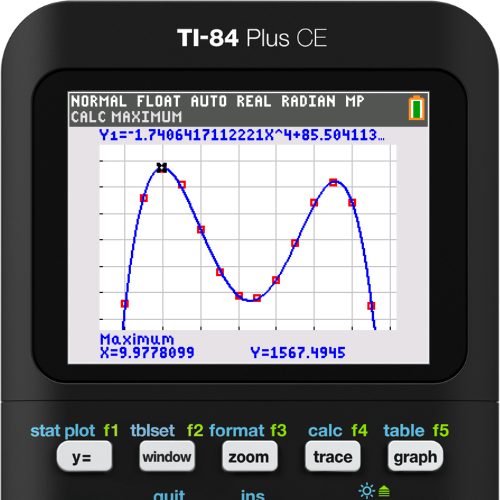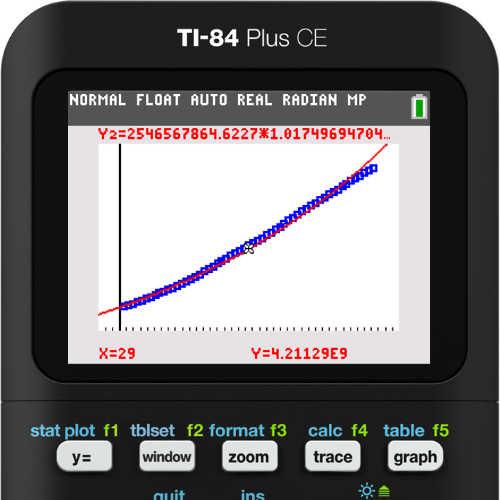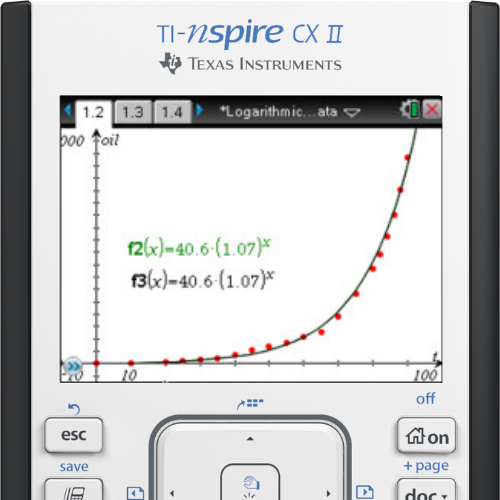Helpful AP® Precalculus resources teachers will love
Posted 01/03/2024 by Vicki Carter, T³™ National Instructor (@vickimcarter)

This 2023–2024 school year, the AP® Precalculus course became a reality for both teachers and students. Last spring, the College Board released its Course and Exam Description (CED) and trained consultants, like me, to deliver 2023 summer institutes to teachers. With this training in mind, I’ve gathered resources to help teachers stay on track with the course’s mathematical principals and the technology knowledge needed for exam success.
Technology plays an important role in this new course, as its use is required on parts of the exam.
To help in your transition to teaching this new AP® course, I am covering:
- The AP® Precalculus course goals and purpose
- The AP® Precalculus exam and technology use
- Teaching support for AP® Precalculus teachers
- Classroom activities for AP® Precalculus


The AP® Precalculus course goals and purpose
A third of college students end up spending time and money on remedial math courses that don’t count toward their degrees because they lack sufficient math skills.* This is a staggering reality and a key motivation in the development of the AP® Precalculus course.
Whether you are already teaching this course or will begin teaching it next year, it’s good to keep in mind the goals the College Board had for creating this new AP® option:
- Prevent the need for students to take remedial math classes in college.
- Prepare more students for upper-level college math.
- Prepare some students for AP® Calculus AB/BC in high school.
- Expand opportunities for students to earn college credits.
- Prepare a pathway for more students into STEM fields.
During my training to become an AP® Precalculus consultant, many of the topics stood out as excellent preparation for both math and science courses in higher education. Diving into the details of the topics as I prepared resources for both teachers and students, it became very clear that a student who masters this material will have an advantage as they begin to navigate through college math and science courses.
Students who take precalculus in high school are 155% more likely to complete a bachelor’s degree, a higher boost in degree completion than students taking algebra II, trigonometry or calculus.**


The AP® Precalculus exam and technology use
On Monday, May 13, 2024, the first AP® Precalculus exam will be taken by students across the globe. While the course has four units, only the first three units are covered on the exam. The fourth unit is considered additional material that teachers may choose to cover, especially if the topics are part of their local or state standards for precalculus. Some teachers are covering parts of Unit 4 after the exam.
The four AP® Precalculus course units include:
- Unit 1 — Polynomial and Rational Functions
- Unit 2 — Exponential and Logarithmic Functions
- Unit 3 — Trigonometric and Polar Functions
- Unit 4 — Functions Involving Parameters, Vectors and Matrices
At first glance, the content of Units 1 and 2 may seem to be included in algebra II. However, with a deeper dive into the Learning Objectives and Essential Knowledge statements of the course, one can quickly see that there is rich content that will definitely give the students a head start into being successful in future STEM classes.
|
Here are some prompts to consider to promote STEM critical thinking:
|
Technology use on the AP® Precalculus exam
Technology plays an important role in this new course. The College Board carefully considered its integration and how as it applies to the three overall mathematical practices students must master:1) Procedural and Symbolic Fluency
2) Multiple Representations
3) Communication and Reasoning
Like other AP® exams, the precalculus test will be three hours long and divided into two sections: multiple choice and free response. Each section has two parts: one that requires the use of a graphing calculator and one that does not.
Section 1:
- Multiple Choice Part A: No Calculator
- Multiple Choice Part B: Calculator Required
Section 2:
- Free Response A: Calculator Required
- Free Response B: No Calculator
|
Technology notes from the course framework and exam overview (as found on page 15): Technology should be used throughout the course as a tool to explore concepts. In AP® Precalculus, students should specifically practice using technology to do the following:
|


Teaching support for AP® Precalculus educators
Even if you’ve been teaching precalculus for years, everyone is still new to applying the content into an AP® course and exam format. It can be helpful to get insight and training from other teachers and gain professional development credits.
If you are looking for support, especially for technology use on the exam, Texas Instruments offers the Teachers Teaching with Technology™ (T³™) professional development program that features free webinars you can join live or watch later on demand. These sessions are structured to walk you through the core components of the course and are led by T³™ instructors, AP® readers and AP® consultants.
On-demand and live webinars
On-demand webinars let you watch on your own time. They also provide any documents and activity files used in the webinar so you can practice the covered concepts with your students. Live webinars let you participate and get feedback directly from presenters, and also may help you earn continuing education credits. I co-presented the introduction and Unit 1 sessions.Here are the available on-demand webinars. You can find a list of all of the recorded AP® Precalculus sessions, or select specific topics below.
- AP® Precalculus – The Course, the Exam, and TI technology
- AP® Precalculus Unit 1: Covariation and Rates of Change in Polynomial and Rational Functions
- AP® Precalculus Unit 2: Modeling with Exponential and Logarithmic Functions
- AP® Precalculus Unit 3: Building Sinusoidal Models and Polar Graphs
- AP® Precalculus Unit 4: Exploring Parameters, Vectors and Matrices
Sign up for upcoming Live T³™ Webinars
Starting in January 2024, TI will host additional webinars focused on using TI technology in AP® Precalculus. (I’ll be co-presenting the session in February on multiple representations along with Steve Phelps.)
These webinars take place on Tuesday evenings at 7 p.m. Central time. Register for upcoming sessions here.
- Jan. 16, 2024 – AP® Precalculus: Develop Procedural and Conceptual Fluency Using TI Technology
- Feb. 13, 2024 – AP® Precalculus: Interpret and Connect Multiple Representations Using TI Technology
- Mar. 12, 2024 – AP® Precalculus: Engage Students in Interpreting, Reasoning and Communicating About Concepts Using TI Technology
- Apr. 9, 2024 – AP® Precalculus: Modeling With TI Technology
Precal Live! on YouTube
In addition to the webinars, Tom Dick and Steve Kokoska are hosting monthly “Precal Live!” sessions on TI’s YouTube channel for both students and teachers. The addition of having both students and teachers participate helps to make this series an interactive, informative exchange about precalculus content and the use of technology.Each session begins at 7 p.m. Central Time on a Thursday night. The discussion questions for each even are posted about a week before the session.
If you have a specific question you would like us to discuss, please email it to our moderator Curtis Brown at curtis@ti.com.
You can watch previously recorded sessions:
- Rational Functions: Zeros, Holes, Vertical Asymptotes and End Behavior
- New Functions from Old: Inverses, Transformations and Compositions
- Difference Quotients and Average Rates of Change
Also, sign up for notifications for upcoming events. The spring schedule will be announced soon.


Classroom activities for AP® Precalculus
TI has a number of ready-to-download activities to use that are compatible with either the TI-84 Plus or TI-Nspire™ CX families of graphing calculators.
Let’s look at some of these premade activities you could use for each unit topic.
Unit 1 activities
Ride the RollercoasterStudents will use polynomial regression to develop and asses the fit of equations modeling data. The equation models are then evaluated for reasonableness in their use for extrapolating beyond the given data sets. This is a great model to discuss cubic and quartic regressions. Students will enjoy applying their technology skills to the model of a roller coaster.

Technology Tip: The Transform App on the TI-84 Plus CE is very useful when working with transformations of the various functions in the course.
Polynomial Rollercoaster
Students will determine and analyze a polynomial model for a roller coaster track. They will use translations and construct cubic equations to fit various criteria. This is a great model to discuss cubic regression, and students will enjoy applying their technology skills to the model of a roller coaster.

Unit 2 activities
World PopulationIn this activity on exponential functions, students use their graphing calculator to explore world population data. They will develop various equations to model the data.

Logarithmic Transformations of Data
Students will understand how various data transformations can be used to achieve a linear relationship and, consequently, how to use the methods of linear regression to obtain a line of best fit. This activity could be used as a review of logarithmic data and the connection to semi-log plots.

Technology Tip: Using sliders on the TI-Nspire™ CX II graphing calculator is very useful when working with transformations of the various functions in the course.
Unit 3 activities
Vertical and Phase ShiftsStudents explore vertical and phase shifts of sine and cosine functions, after a brief review of period and amplitude. This is a great model to help students visualize transformations of the sine and cosine functions.

Sinusoidal Modeling
Students will input data, plot the data and use parameter sliders to fit a curve to model the data with a sinusoidal model. This is a great model to discuss sinusoidal regression with data that the student has an opportunity to research on the internet.

TI has a selection of precalculus activities to explore for the TI-84 family of graphing calculators and TI-Nspire™ technology.

Keep learning with Texas Instruments
In conclusion, TI has a variety of resources to assist teachers in presenting this new course with technology. I recommend exploring their online learning and activities sections as well. You can also sign up for emails to stay in the know on topics relevant to you.
You can also subscribe and sign up for alerts @TIcalculators on YouTube for the latest math resources, as well as calculator and testing tips.
I hope you find these resources helpful and wish you and your students success on exam day!
About the author: Vicki Carter is a retired math teacher splitting time between her home on an airport (yes, they have a hanger in the back yard) and her happy place on Black River near the coast of South Carolina. Although her grandchildren now get most of her attention, she still loves working with TI to provide resources, conference sessions and webinars. Vicki retired in June of 2022 after 46 years at West Florence High School in Florence, South Carolina. She is a T³™ National Instructor. She also serves as an AP® Precalculus Consultant.
*Chen, X., Remedial Coursetaking at U.S. Public 2- and 4-Year Institutions: Scope, Experiences, and Outcomes (National Center for Education Statistics, 2016). Retrieved from: nces.ed.gov/ pubsearch
**Trusty, Jerry, and Spencer G. Niles, “High-School Math Courses and Completion of the Bachelor’s Degree,” Professional School Counseling vol. 7, no. 2 (December 2003), 99–107.
